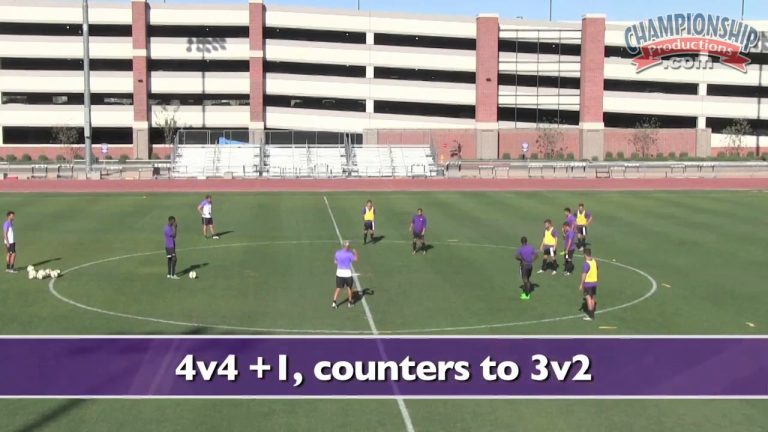Off-ball movement is a strategic element in football that can make or break a team’s counterattacks. It is the art of creating space and exploiting gaps in the opponent’s defense without the ball. With precise timing and intelligent positioning, players can make themselves available, giving their teammates more options to launch devastating counterattacks. In this article, we delve into the importance of off-ball movement for counterattacks and how it can turn the tide of a game in favor of the attacking side.
What is the importance of off the ball movement?
Off the ball movement is crucial in any territory/invasion game. It plays a significant role in creating opportunities for both the individual player and the team as a whole. By constantly moving to space, players can effectively draw away the defense, leaving more room for their teammates to exploit. This not only increases the chances of scoring, but also allows for seamless passing and unchallenged receptions. From covering and supporting to guarding and adjusting, off the ball movements are the key to unlocking success on the field.
In the world of sports, off the ball movement is a game-changer. With its ability to create openings and disrupt the opponent’s defense, it has become an essential skill for any player. By understanding the importance of covering, supporting, guarding, and adjusting, athletes can make intelligent decisions that benefit both themselves and their team. Off the ball movement not only enhances the fluidity and coordination of a game, but it also showcases the strategic prowess of players who can seamlessly navigate the field. Mastering this skill is the secret to unlocking victory and dominating the game.
What are the strategies employed for defending against counter attacks?
Counter attack defense requires a combination of tactical, physical, and psychological tactics to effectively thwart the opponent’s advances. First and foremost, a tactical approach entails strategically channeling the play into areas where your defensive strength lies. By positioning your players strategically, you can limit the attacking team’s options and increase the likelihood of regaining possession.
In addition to a tactical approach, a physical aspect is crucial in counter attack defense. This involves closing down spaces rapidly, denying the opposition time and room to maneuver. Even when outnumbered, defenders must prioritize defending the space behind them while simultaneously preventing any forward passes. This proactive approach disrupts the opponent’s rhythm and hinders their progress towards your goal.
Lastly, a psychological element plays a vital role in counter attack defense. When a defender recovers possession, their immediate objective should be to swiftly retreat behind the ball. This not only provides additional defensive cover but may also result in a chance to regain possession. By instilling a sense of urgency and determination in defenders, the team can effectively neutralize any counter attack threats.
In summary, counter attack defense requires a comprehensive approach that incorporates tactical, physical, and psychological tactics. By strategically channeling play, closing down spaces, and rapidly recovering behind the ball, teams can effectively thwart the opponent’s advances and maintain a solid defensive stance.
What is the meaning of moving off the ball?
Off the ball movement is a dynamic aspect of the game that often goes unnoticed. It refers to the strategic positioning and actions of a player without the ball. Whether it’s creating space for a teammate or making a run to receive a pass, moving off the ball is crucial for a team’s success. It requires awareness, speed, and a deep understanding of the game.
When a player moves off the ball, it disrupts the opponent’s defensive structure and opens up scoring opportunities. It can involve making diagonal runs, dropping deep to collect the ball, or pulling defenders out of position. By constantly shifting and finding pockets of space, players can create passing lanes and exploit weaknesses in the opposing team’s defense.
Mastering off the ball movement requires practice and coordination with teammates. It’s about making intelligent decisions based on the game’s flow and the positions of both your teammates and opponents. By constantly being on the move and anticipating the play, players can maximize their impact on the game, creating space and opportunities for themselves and their teammates.
Mastering the Art of Off-Ball Movement: Unleashing Unstoppable Counterattacks
Paragraph 1:
In the realm of sports, mastering the art of off-ball movement is a skill that separates the exceptional from the average. It is a weapon that, when unleashed strategically, can lead to unstoppable counterattacks. Off-ball movement refers to the ability of players to navigate the field or court without the ball, creating space and confusion for the opposition. By understanding the importance of timing, positioning, and communication, athletes can become masters of off-ball movement, unlocking a whole new level of attacking prowess.
Paragraph 2:
Timing is everything when it comes to off-ball movement. A split second can be the difference between being marked tightly or finding a gap in the defense. Skilled athletes have an innate sense of when to make their move, whether it’s a swift change of direction or a perfectly timed run into open space. By constantly analyzing the game and anticipating their teammates’ actions, players can navigate the field with precision, setting themselves up for devastating counterattacks.
Paragraph 3:
Positioning and communication are vital components of mastering off-ball movement. Players must constantly be aware of their surroundings, reading the game and adjusting their positioning accordingly. By strategically positioning themselves between defenders or exploiting gaps in the defense, athletes can create opportunities for themselves and their teammates. Effective communication is also crucial, as it allows players to coordinate their movements and execute seamless counterattacks. With synchronized off-ball movement, teams can unleash an unstoppable force, leaving their opponents bewildered and struggling to keep up.
Subtitle: Mastering the Art of Off-Ball Movement: Unleashing Unstoppable Counterattacks
Unveiling the Secrets of Off-Ball Movement: Dominating with Counterattack Strategies
Unveiling the Secrets of Off-Ball Movement: Dominating with Counterattack Strategies
Unlocking the power of off-ball movement is the key to dominating the game with counterattack strategies. As players seamlessly glide across the court, they create openings, confuse opponents, and pave the way for swift and lethal attacks. With precise timing and strategic positioning, the art of off-ball movement becomes a formidable weapon, enabling teams to dismantle even the strongest defenses. By unleashing this secret, teams can unleash a wave of relentless attacks, catching their adversaries off guard and securing victory.
In the realm of counterattack strategies, off-ball movement reigns supreme. As players break free from their defenders and strategically position themselves in open spaces, they create a web of confusion that leaves opponents scrambling to regain control. With lightning-fast passes and razor-sharp precision, they exploit these gaps, launching devastating counterattacks that leave the opposition stunned. By mastering the intricacies of off-ball movement, teams can turn the tide of any game, transforming themselves into unstoppable forces that dominate the court and claim victory with style.
Incorporating intelligent off-ball movement is vital for successful counterattacks. By seamlessly positioning themselves to exploit spaces left by the opposition, players can swiftly transition from defense to offense, catching their opponents off guard. Off-ball movement not only disrupts the defensive structure but also allows for quick and incisive attacking plays. It is through this strategic and dynamic approach that teams can capitalize on counterattacking opportunities, ultimately leading to game-changing moments on the field.



